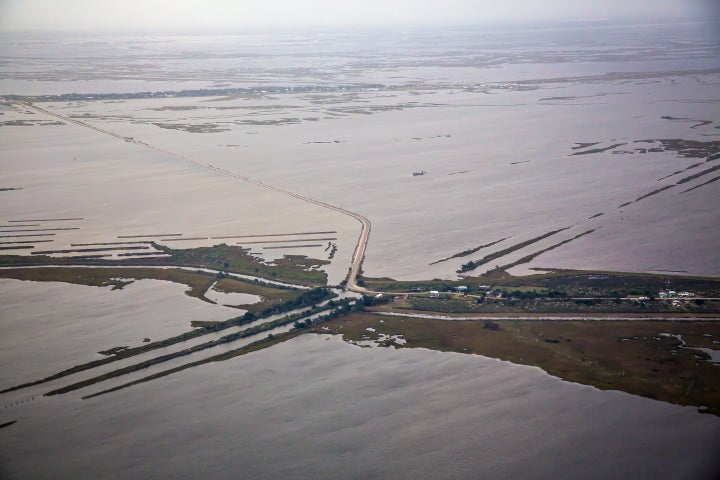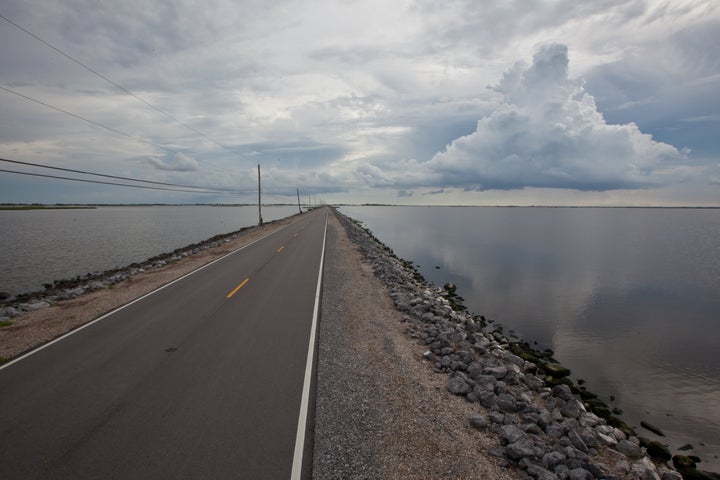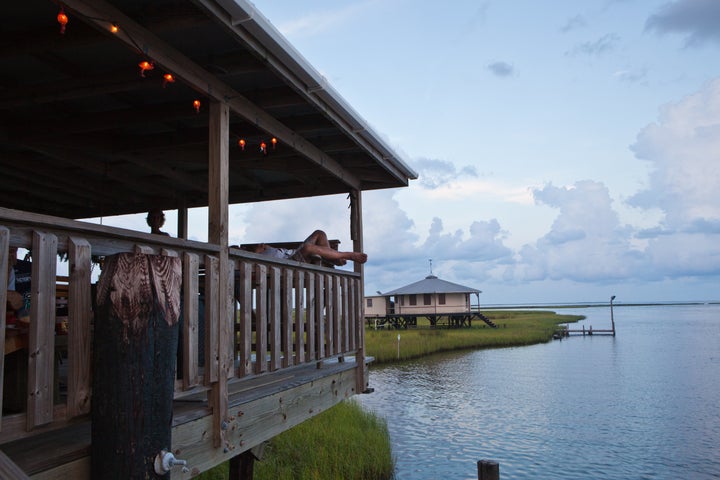
A small Louisiana tribe hoping to reunite its members in a new, upland community before their island home disappears under rising seas is now watching that goal recede.
In January 2016, the Department of Housing and Urban Development awarded the state of Louisiana $92 million for disaster resilience in coastal communities facing rising sea levels, wetlands loss and increasingly severe hurricane damage. Of that amount, $48 million was earmarked for the relocation of the Isle de Jean Charles Band of Biloxi-Chitimacha-Choctaw Tribe. Isle de Jean Charles lies in Louisiana’s bayou country, about 80 miles southwest of New Orleans, and has seen a 98-percent loss of land since 1955.
The 600-member tribe had been planning to relocate for two decades, and rejoiced at the news the project was finally moving forward. The plan has received plenty of national media attention, heralded as the “only government-funded climate relocation in the country” and the tribe as the “first American ‘climate refugees.’” But just a few weeks after the plan was announced, the tribe got bad news: The state of Louisiana had decided to change the project’s scope after a rival tribe intervened, claiming that they have jurisdiction because some of their members live on the island. And now the state is moving forward with a plan that many tribal leaders aren’t happy with.
Most of the residents of the Isle de Jean Charles Tribe (IDJC) are descendants of Biloxi, Chitimacha and Choctaw people who retreated deep into forbidding bayou country — locals call the region “down bayou”—to escape the brutal forced relocations of Southeastern tribes under the Indian Removal Act of the 1830s. Over the years, the 22,000-acre island became a thriving, self-sufficient community, led by a line of hereditary chiefs.
But decades of levee construction, land subsistence and sea level rise have shrunk the island to just 320 acres. Most tribal members, including almost all the leadership, were forced to retreat to higher ground to keep jobs or preserve their household assets. Today, less than 100 residents, most of them natives, are left. The grant allocated to the tribe would allow them to create a new community for all tribal members and current island residents so they could be reunited, with a 2022 deadline to complete the move.

The tribe’s community plan was developed with assistance from several nonprofits and architects working pro bono. It included 175 sustainable homes, health and wellness facilities, agriculture and aquaculture, meeting spaces and classrooms, all incorporating facets of the tribe’s culture and economy into a town that could grow with the generations.
The plan called for island residents to be relocated first, since they are in the most precarious situation. Other tribal members would be able to move to the new town after that. If the state hadn’t intervened, the new location would likely be chosen by now, and pre-construction started. Now construction at the new location isn’t expected to start until June 2018.
The problems started when the United Houma Nation wrote to Louisiana Gov. John Bel Edwards about four weeks after the relocation plan was first announced in 2016, stating that they were “shocked that we were never informed and brought to the table in the discussion.”
Houma Principal Chief Thomas Dardar Jr. wrote that 34 of its 18,000 tribal members were among the island’s remaining residents, but he felt they “were not brought to the table” for the discussions. The Houma Nation, he wrote, had already acquired property “to implement a nearly identical community development plan.”
Patrick Forbes, executive director of Louisiana’s Office of Community Development, said his office enacted several changes to the plan after that letter. “We were under the understanding that we were dealing with just one tribe,” said Forbes. “We realized we had a different situation on the ground than when we wrote the application.”
Even after Isle de Jean Charles’ Hereditary Chief Albert Naquin Jr. addressed the Houma tribe’s statements in a subsequent letter, and despite further attempts to address the state’s concerns, the original project was curtailed. Under the revised plan, remaining Isle de Jean Charles residents will receive new homes first, then those who were displaced after Hurricane Isaac in 2012. Any remaining tribal members ― including those who have already relocated themselves ― will be on their own, and may have to compete with non-Indians for home plots in the new community.
“We won’t restrict who can buy and build a house in the new community,” Forbes said in February. “We understand the IDJC’s desire to reunite everybody, but that’s not how we can run the project.”
He said the state is bound by the federal Fair Housing Act, which prohibits discrimination in housing, to “treat everybody [who lives on the island] the same.” While federally recognized tribes are exempt from FHA’s requirements, none of the tribes on the island are federally recognized (though they are able to get housing funding through HUD).

The Louisiana Office of Community Development formed a new advisory committee for the relocation that included the daughter of the island’s marina owner, who is a Houma citizen. The state also hired new architects to recreate the town’s master plan, and held new community meetings. This week, Louisiana announced it has selected a location for the new town: a 515-acre site in north Terrebonne Parish, about 40 miles away.
All the changes have already put the project two years behind. Naquin said he is extremely concerned about how the tribe’s plan went awry. “This was supposed to be just for us,” he said. “The state is changing how this works.”
Social anthropologist Steven L. Austin works with tribes across the United States, and while he’s not involved in this case, he said the dispute between the tribes predates the relocation. Documents indicate that the Houma and the Chitimacha lived near each other as far back as the late 1700s and early 1800s and “definitely did not like each other very much.” The Houma were also incensed when IDJC and two other smaller tribes pulled out of the Houma Nation in the mid-1990s. He also said that the Houma have long attempted to claim the Isle de Jean Charles land as their own, and do not acknowledge Naquin as the tribal leader.
Naquin and the other the Isle de Jean Charles leaders “did all the work to make sure that people in the island community did not end up completely under water and homeless,” said Austin in an email. “As I understood from him, his intention was to see that every person on the island, even a white family that moved there in recent years, would benefit.”

Houma’s assertion that it can intervene in IDJC’s plan “is not necessarily illegal,” said attorney Gabriel S. Galanda, an enrolled member of the Round Valley Indian Tribes of California, ”but it is highly unethical and immoral.”
“And, it is simply not how indigenous peoples behaved historically,” he continued.
Naquin says Houma’s leaders were invited to meetings to discuss the IDJC’s relocation project, but chose not to attend.
The United Houma Nation did not respond to requests for comment.
Naquin said his tribe had been working to raise the additional $62 million needed to finish the project beyond federal grants, but the state’s abandonment of the plan to create a Isle de Jean Charles tribal community homeland has slowed them. “We’ve had philanthropic organizations say they are reconsidering providing the remaining funding,” he said. “I’m beginning to wish we had gone a different route to relocate our people.”
Under the new plan, the IDJC has little control over the new location and what gets built there. The state’s website indicates that representatives met with the IDJC leadership only once, in July 2016, before forming the new committee, and the state is working almost exclusively with current island residents to determine the future of the project. The rest of the tribe is treated only as “other stakeholders.” And while construction on the new location is supposed to start this summer, it’s not clear when anyone will actually start moving there, although the state has said it intends to stick to the 2022 deadline.
The delay has left some IDJC tribal members struggling to keep life together on a disappearing spit of land, while other tribal members are spread over the region.
“Every day that we’re not back together, we’re losing our culture,” said IDJC Councilman Tommy Dardar. “Baskets aren’t being made, gardens aren’t tended, we’re having to eat unhealthy foods. We took a lot of time away from our families to make this happen. I wish we had never started this.”
CORRECTION: An earlier version of this article incorrectly stated that the daughter of the marina owner is a non-Native. She is a member of the Houma.
